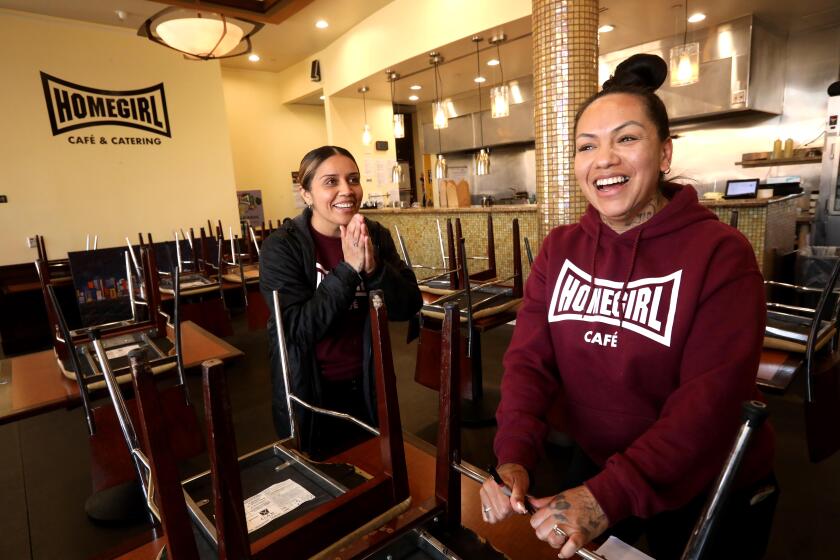Setting Times stories to music: From Perry Como to Dr. Dre
The other night I drove over to Christmas Tree Lane in Altadena. The night was clear. The stars vied with the glowing lights on the trees, and lost.
This is how it works. You turn off all but your parking lights and coast slowly downhill, then drive back up again. (Repeat as needed.) As the lights drift overhead on the branches of the giant deodars, it feels like you’re floating through Christmas.
Feeling a little frazzled with your 21st-century holiday season, with its online shopping and virtual friendships? Go to Christmas Tree Lane and feel like you’re in another century. It’s no corporate extravaganza, just a community effort that began in 1920 and has continued ever since, except for a couple of years during World War II.
One of this week’s Great Reads reminds me a little of Christmas Tree Lane. Chuck Cecil has hosted his “Swingin’ Years” radio show since 1956, keeping the music of the big band era alive. The story is full of wonderful details of his rich past: seeing “a skinny singer named Frank Sinatra” at the opening of the Hollywood Palladium in 1940, double-dating with local girls Jane Russell and Norma Jean Baker before they became movie stars (and Miss Baker became Marilyn Monroe.)
It’s grand to know that Chuck Cecil and Christmas Tree Lane endure, and remind of us of our analog selves.
Anyway, in these roundups of the week gone by, I’d like to offer the first paragraphs of each Great Read (or, as they’re known in print, Column One) -- maybe they’ll buy your eye and you can settle in for a good weekend read. And you’ll also get the songs that inspired me while editing the stories, or reading them later if my fellow editor Millie Quan ushered them through. A story-song combo!
#
Boyle Heights tailor is the master of mariachi suits
Those with big bellies tend to ask:
“Jorge, can you please make me look thinner?”
The tailor’s answer is always the same: “I don’t think so. But when I’m done, trust me. You’re going to look good.”
For 30 years, Jorge Tello has dressed Los Angeles’ most stately and most picky performers — the mariachis.
He takes their measurements, tweaks their bow ties, hems their cuffs and stitches on their greca, or suede embroidery. They serenade him and tell him their adventures — of the countless weddings and funerals they’ve sung at, of the women who tempt them, of the love they have for an art that most months hardly pays the bills.
His customers are characters, with nicknames impossible to forget: El Hamburger. El Caballo. The Mule. The Beast. The Tomatillo.
They call the tailor El Maestro.
Clients flock to his shop in Boyle Heights from Idaho, Miami, New York and New Jersey, even from England and Switzerland. They come willing to pay big, as much as $4,000, for one of his handmade suits.
Most are grizzled musicians with thick mustaches and commanding voices. Others are wannabe cowboys eager to boast. And then there are the stars: Carlos Santana. Placido Domingo. The Chihuahuas of “Beverly Hills Chihuahua 3.”
Tello, a small, reserved man, works methodically atop a stool, using a chalk pencil and an old ruler to cut patterns for each order. He’s been around so long, he’s dressed three generations.
“First, the father, then the son, then the grandson,” he said with a grin that comes easily and often. “Can you imagine? I’m still trying to understand how they let me into this world.”
His shop has become just what Tello named it: La Casa del Mariachi.
#storysongs combo: “Malagueña,” by Mariachi Vargas de Tecalitan. Everything—the voice, the strings, the suits.
#
In Honduras, rival gangs keep a death grip on San Pedro Sula
We are driving into the meanest neighborhood in the murder capital of the hemisphere, if not the world.
“Roll down your windows,” the driver says.
“Down??”
Edgardo seems to think it best that people see who we are as we drive in, that we are clearly not a rival gang.
This is the Chamelecon barrio of San Pedro Sula, part of a network of turfs on the city’s south side that are the realm of vicious gangs.
Each neighborhood has a code of survival. People from one do not venture into the other. The distance can be a matter of a few blocks. This means workers can’t get to their jobs and families have had to stop sending their kids to certain schools. Threatened households have packed up and left, leaving behind full closets, children’s toys — and lifeless streets.
The gangs charge what residents call a war tax, extorted from homes and businesses, down to the smallest fruit vendor. You don’t pay, you get out. And if you don’t go, you get killed.
In the section of Chamelecon where nurse Suyapa Bonilla runs a private clinic to help gangsters remove tattoos, the Mara Salvatrucha is in charge. As long as residents of the neighborhood respect the code, the gang will respect the residents, she says.
When residents drive home at night, they flash their headlights several times to signal they belong there. Or, during daylight, they roll down their car windows. They learn to sleep on the floor of their homes during gun battles. And they know better than to call the police.
Any problems are handled by gang delegates. A woman whose husband has beaten her calls someone who relays the problem to the gang, who sends someone to speak to the man. The rare home robbery — rare unless sanctioned by the gang — is similarly reported to the young men who hold sway in the neighborhood. What exactly they do with the culprit is unclear.
“Sure, they are violent, but they respect the barrio where they live,” Bonilla said. “It is their law. It makes the skin crawl.”
#storysongs combo: “Murder Ink,” by Dr. Dre. OK, so I have to offer the edited version, which is actually kind of hilarious because of all the gaps.
#
Wednesday’s Great Read: (Not an uppercase Great Read, but a great read.)
Buses are their route to a brighter future
It is 5:35 a.m.
“Let’s go,” Carmen says to Andy, 14, and Nicole,11, as they head up the street toward their Florence Avenue bus stop, all of them wearing backpacks.
On weekdays, Carmen Mendoza does not see the sun in her Bell Gardens neighborhood. She’s out the door with her two kids before dawn, and the evening darkness always beats her home.
One reason for the 15-hour days is that like thousands of people in a region built for the automobile, Carmen Mendoza doesn’t own a car. So she and the kids commute to work and school by bus, with lots of transfers along the way. On a typical day, the bus that takes them back home is their eighth or ninth of the day.
I joined them for the journey recently, meeting Mendoza and her kids as they emerged from their home to go catch the first bus of the day.
Nicole is still tired, and Andy seems to be sleep-walking, but to look at their mother, you wouldn’t know the hour was so indecent. She has bounce in her step, and there is something expectant in her eyes.
About 1.1 million times a day, someone boards a Metro bus in greater Los Angeles. Metro officials say 79% of their riders list themselves as “transit dependent,” 90% are minorities, and the average household income is $25,540.
#storysongs combo: “Does This Bus Stop at 82nd Street,” by Bruce Springsteen. I can’t remember when I last listened to the “Greetings from Asbury Park” album. Springsteen in pure storyteller mode.
#
For radio host, big bands’ allure endures
Chuck Cecil went to his first big band show in 1939, driving with three high school friends in a Model A Ford to South Gate to see bandleader Jimmie Lunceford at the Trianon Ballroom.
The following year, he was at the opening of the Hollywood Palladium to see Tommy Dorsey and a skinny singer named Frank Sinatra.
Nearly three-quarters of a century later, Cecil is still swinging to the same music: His weekly big band radio show, “Swingin’ Years,” has been on the air almost continuously since it debuted in 1956.
It began as filler for an empty Saturday morning slot on Hollywood’s KFI station and was later syndicated to more than 300 stations nationwide and broadcast internationally, on 240 ships and 170 military bases, by Armed Forces Radio Network. Though the show is now heard only on Long Beach’s KKJZ and Long Island’s WPPB, it reaches an average of 46,000 listeners a week.
His cheery Midwestern tones larded with corn-pone quips like “Let’s split an egg and fry a watermelon,” Cecil intersperses big band music with factoids about the songs and firsthand memories of the men and women who recorded them — the Detroit Tigers, for instance, were winning the World Series the day Bing Crosby recorded “Only Forever.”
Now almost 91, the host seems a little mystified by the show’s longevity — but not by the long-lived popularity of the music.
“It was an emotional time, and a hardship time, but it was a survival time,” said the slim, white-haired Cecil, dressed in denim jeans and a chambray shirt that brought out the blue in his eyes. “That’s why the music was so treasured. It did lift people’s spirits during the Depression and the war.”
#storysongs combo: “They Say It’s Wonderful,” by Perry Como. This was Cecil and Edna’s song. Puts me in a happy mood to hear it.
#
Iraq veterans find the war at home is with red tape
Glenda Flowers stood at the edge of a crowd of angry veterans at San Francisco’s War Memorial building. They had been waiting months, even years, to hear whether they would receive disability benefits, and they were tired of excuses.
Flowers, a 31-year-old Iraq veteran and mother of two, had come to the meeting with a pair of Veterans Affairs officials because she wanted to be heard. But she was trying too hard to fight back tears to take the microphone.
The social worker who accompanied her couldn’t let her be overlooked.
“Nobody brought up here that a lot of these young vets have children,” said Marcy Orosco, who heads a Salvation Army transitional housing program in San Francisco. “Because of this wait, she was living in her car with her children.… What are you going to do about that?”
Flowers, a small, compact woman eager for adventure, thought the Army would be her life. But when her marriage to a fellow soldier and her mental health collapsed under the strain of their tours to Iraq, she found herself alone with her children facing the prospect of another deployment.
She left the Army in January 2010 and submitted a benefits claim the same month, citing post-traumatic stress disorder and injuries from years of parachute jumps, among other ailments.
She didn’t know it at the time, but her application would become a case study in the kinds of issues that can delay a claim.
Another Iraq veteran, Ari Sonnenberg, said the agonizing wait and bureaucratic bungling added to an already painful transition to civilian life. He wonders how many people will want to serve in the future.
“I never used to understand why the Vietnam guys were so bitter,” he said. “We’re very quick to send people to war, but we’re super slow taking care of those people that actually make that sacrifice.”
#storysongs combo: “Think You Can Wait,” by the National. “I was drifting, crying/I was looking for an island/I was slipping under.” A sadly beautiful song.
#
If you have ideas for story-song pairings of your own, tweet the title and artist to @karihow or @LATgreatreads with the hashtag #storysongs.
More to Read
Start your day right
Sign up for Essential California for news, features and recommendations from the L.A. Times and beyond in your inbox six days a week.
You may occasionally receive promotional content from the Los Angeles Times.






